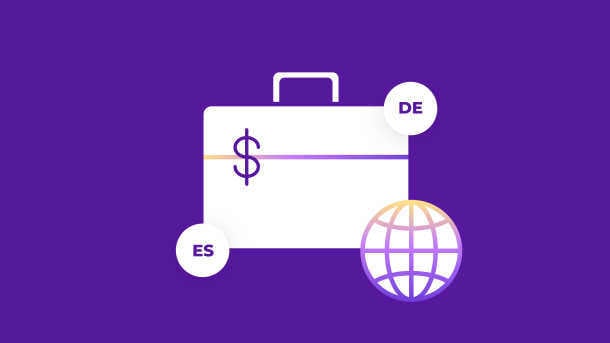In 2022, there were 1.5 billion English speakers. This makes English the most widely spoken language in the world. Still, billions more speak 7,000+ other languages known today. Chances are high that part of your audience is among them. This is why you can’t discount the importance and value of content translation.
Why content translation matters
Content translation improves global marketing in several ways. Here are a few benefits you’ll see when you make your content available in other languages.
1. Content translation increases your reach
You might be surprised at how much of your global audience you have yet to reach due to language barriers. But the question is: How much of that untapped audience has been reached by your competition? If competitors are translating their own high-quality content, you could easily lose thousands of dollars, customers, or users to them. Content translation doesn’t only increase your reach. It can also help you compete with or give you an edge over competitors.
2. Content translation improves user experience
65% of users prefer content in their own language, even if the quality is lower. As long as the translation is accurate, content and user experiences are always better in a person's native language. Even if that individual understands some English. In turn, better user experiences promote engagement. And they build the trust needed to drive signups and other conversions.
3. Boosts your return on investment (ROI) from content
It’s not difficult to see why content in a person’s native language is so powerful. People are more likely to take action—whether that be making a purchase or otherwise converting—if they fully understand your message and its relevance to them. The same is true if they understand how to enjoy the benefits of your product or service. These two truths ultimately lead to a better return on your investment in content.
How content translation increases your revenue
Now, let’s talk about how translating your content can boost revenue specifically. Translating your content can give you access to thousands or millions of potential customers and users. If your marketing, messaging, and user experience are effective, two things will happen:
- You’ll earn more paying customers.
- You’ll retain more paying customers.
As a bonus, loyal customers often become brand advocates who help grow revenue even more. To illustrate, this was the case with Canva as it used Smartling to reach 30 million non-English speaking users. One of Canva’s key measures for success was retention. Its localization efforts, which included translation, no doubt boosted revenue as well.
How to get started with content translation
Now, the real question is this: How can you set yourself up for a successful content translation project?
Define goals and priorities
Clarify what you hope to achieve by translating your content into different languages. Then, break that big-picture goal down into smaller goals (quarterly objectives, for example).
What content would you need to translate to progress toward the outcome you’re after? This is where the consideration of cost vs. reward comes in. On a project that required launching a company website in five languages, Eric Doty, Content Lead at Dock, said:
“We had lots of English content and very little in the other languages. We initially planned to translate everything into the other four languages, but the cost was going to be huge. Plus, most of our growth was going to take place in English-speaking markets, so we had to weigh the cost of translation vs. the potential financial benefit. Ultimately, we decided only to translate a portion of the content.”
You’ll also need to identify high-priority content (across content types). For instance, as far as website content goes, your main pages and highest-converting landing pages are often good candidates. But, in some cases, more testing may be needed.
Eric recommends testing content in one market first “because the cost to produce a piece of content scales with the number of languages you translate to. It’s best to produce the content in one language first, see how it does, and then translate it only if it performs well or has high business impact potential.”
Yet, to even get to this stage of testing, you need to have a translation process in place.
Develop a translation process and assign roles
Think through the following:
- How and when will you surface content for translation? (Hint: Translation management software like Smartling automates this for you.)
- Will your process be human-driven or use machine translation, or machine translation post editing?
- What are your timelines? Especially for time-sensitive content or for pieces that require the involvement of a design team, for example, before they can go live. Then, put in place resources and tools that will help you stay within the appropriate timeframe. For example, Smartling enables translations to go live instantly with neural machine translation, or in as little as two days with human translation.
- Which language service providers meet your current and future translation needs? Customers who switch to Smartling Language Services not only receive accurate translations but also save up to 20% on cost per word.
Plus, for the most scalable translation strategy, let your people have a say in the workflow—not just in general, but for high, medium, and low-priority content specifically. Flexibility is key to minimize time pressure and costs while still outputting multilingual content at the pace you need.
Wrangle relevant assets
To translate content into different languages accurately, everyone involved in the process must be well informed. Round up helpful resources. These could include brand guidelines, content that embodies your brand voice, and links to relevant pages. And, most importantly, a brand glossary that defines terms specific to your company and how they should be translated.
Get to know your target market(s)
Market research is a crucial step in the process. Effective content isn’t only available in the language of the reader. It also considers the market and the cultural and regional differences between the source and target languages. Ultimately, you should invest in localization rather than translation alone. You don’t necessarily need to know the nuances of the markets you’ll translate content for, but your translators definitely should. (That’s why Smartling works with linguists who translate into their native languages.)
What can go wrong and how to make it work
The steps above will go a long way to get you started. But you’re bound to run into content translation challenges of some sort. And the more languages you need to translate content into, the higher that likelihood becomes. For example, it’s not always straightforward to translate the following:
- Language structure. Each language has its own structure and rules, some of which are discussed in our guide to translating for EMEA markets. Depending on your target and source languages, adding, removing, and rearranging words may be necessary for your content to be clear and effective.
- Figures of speech. These are among the hardest aspects of content to translate. There’s not always an equivalent in the target language for idioms and expressions that are common in a source language. Smartling is the only TMS in the market that has a transcreation tool specifically built to address this.
- Words with several meanings. Selecting the wrong word in a target language can negatively impact the meaning or coherence of a sentence. But it can be easy to mix up words with the same spelling in the source language but different meanings. This is why your glossary is so important.
In general, one of the biggest challenges is keeping quality high across all markets. For example, Marelle Ellen, the CMO at Promoty, worked on a project where each market had only one Country Manager handling translation.
Marelle says, “There was no person with marketing knowledge. So, I had to constantly give them input on content, make sure on-page SEO principles were followed, and ensure that all the social media channels were active.” Yet, content translation is still complex in cases where there’s more than one translator. Or when the team includes several people with marketing expertise.
Thankfully, there are ways to combat this. For instance, Marelle and the Promoty team “set monthly goals for every market (e.g. ‘we should get at least one blog post up every month’). Every Country Manager was then responsible for achieving those goals in their market.”
They also held weekly channel meetings (e.g. Instagram meetings) to review progress. Arrangements like these can help, especially on large projects or those where content is translated into several different languages. It’s also wise to use translation management software to automate the translation process as much as possible. This will free up your team’s time to focus on quality control.
Smartling simplifies content translation projects
Smartling’s translation management system centralizes all your translations. It allows you to accomplish the following:
- Assign content to translation workflows automatically, saving you countless hours of manual work
- Upload and optimize linguistic resources such as your style guide, glossary, and translation memory
- Communicate with translators on the string level to ensure translation accuracy
- Easily keep tabs on the status of translations and the cost of your translation projects
Hundreds of brands trust Smartling to manage their localization needs at scale through a combination of software and language services. Smartling’s translation services are provided only by native speakers with local expertise. These meticulously-vetted professional translators both enhance and ensure the quality of translated content.
For more on how Smartling makes it easy to manage even the most complex content translation projects, book a meeting to learn about our software and language services!






